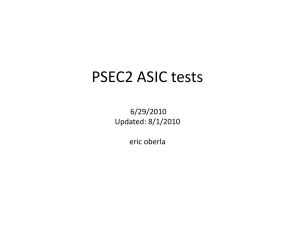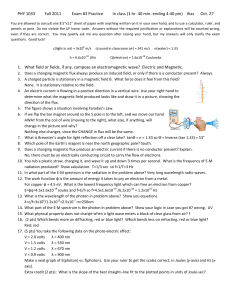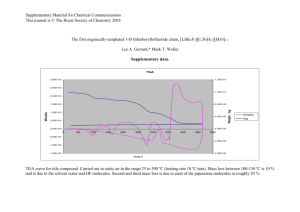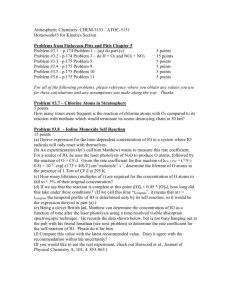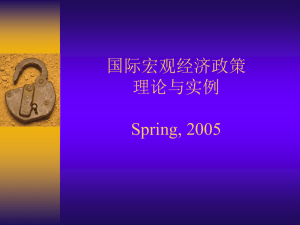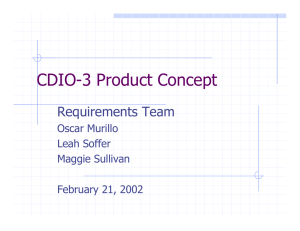INTRODUCTION OF REGULARIZATION TECHNIQUE IN MINIMIZATION METHODS TO
advertisement
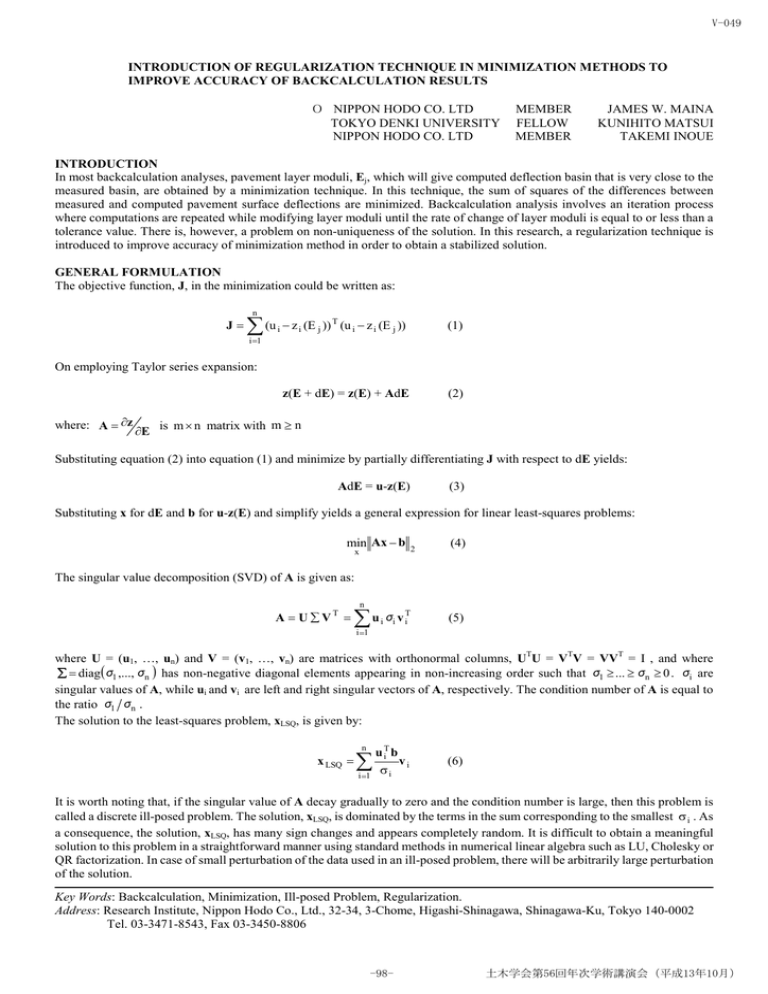
V-049 INTRODUCTION OF REGULARIZATION TECHNIQUE IN MINIMIZATION METHODS TO IMPROVE ACCURACY OF BACKCALCULATION RESULTS О NIPPON HODO CO. LTD TOKYO DENKI UNIVERSITY NIPPON HODO CO. LTD MEMBER FELLOW MEMBER JAMES W. MAINA KUNIHITO MATSUI TAKEMI INOUE INTRODUCTION In most backcalculation analyses, pavement layer moduli, Ej, which will give computed deflection basin that is very close to the measured basin, are obtained by a minimization technique. In this technique, the sum of squares of the differences between measured and computed pavement surface deflections are minimized. Backcalculation analysis involves an iteration process where computations are repeated while modifying layer moduli until the rate of change of layer moduli is equal to or less than a tolerance value. There is, however, a problem on non-uniqueness of the solution. In this research, a regularization technique is introduced to improve accuracy of minimization method in order to obtain a stabilized solution. GENERAL FORMULATION The objective function, J, in the minimization could be written as: n J ¦ (u z (E )) T (u i z i (E j )) (1) z(E + dE) = z(E) + AdE (2) i i j i 1 On employing Taylor series expansion: where: A wz wE is m u n matrix with m t n Substituting equation (2) into equation (1) and minimize by partially differentiating J with respect to dE yields: AdE = u-z(E) (3) Substituting x for dE and b for u-z(E) and simplify yields a general expression for linear least-squares problems: min Ax b x 2 (4) The singular value decomposition (SVD) of A is given as: A U ¦ VT n ¦u σv i i T i (5) i 1 where U = (u1, …, un) and V = (v1, …, vn) are matrices with orthonormal columns, UTU = VTV = VVT = I , and where ¦ diagσ1 ,...,σn has non-negative diagonal elements appearing in non-increasing order such that σ1 t ... t σn t 0 . σi are singular values of A, while ui and vi are left and right singular vectors of A, respectively. The condition number of A is equal to the ratio σ1 σn . The solution to the least-squares problem, xLSQ, is given by: n x LSQ ¦ i 1 u iT b vi Vi (6) It is worth noting that, if the singular value of A decay gradually to zero and the condition number is large, then this problem is called a discrete ill-posed problem. The solution, xLSQ, is dominated by the terms in the sum corresponding to the smallest V i . As a consequence, the solution, xLSQ, has many sign changes and appears completely random. It is difficult to obtain a meaningful solution to this problem in a straightforward manner using standard methods in numerical linear algebra such as LU, Cholesky or QR factorization. In case of small perturbation of the data used in an ill-posed problem, there will be arbitrarily large perturbation of the solution. Key Words: Backcalculation, Minimization, Ill-posed Problem, Regularization. Address: Research Institute, Nippon Hodo Co., Ltd., 32-34, 3-Chome, Higashi-Shinagawa, Shinagawa-Ku, Tokyo 140-0002 Tel. 03-3471-8543, Fax 03-3450-8806 -98- 土木学会第56回年次学術講演会(平成13年10月) V-049 REGULARIZATION METHODS These are practical methods for computing stabilized solutions to the discrete ill-posed problems by diminishing the influence of noise. The underlying argument in regularization is the idea that a regularized solution with small norm and suitably small residual norm is not too far from the desired, unknown solution to the unperturbed problem underlying the given problem. The most common and popular form of regularization is the one known as Tikhonov regularization. The regularized solution x λ is defined as the minimizer of the following weighted combination of the residual norm and the side constraint ^ x λ argmin Ax b 2 2 λ2 x 2 2 ` (7) where the regularization parameter, O , controls how much weight is given to minimization of x 2 relative to minimization of residual norm. Since the purpose of regularization is to dampen or filter out the contributions to the solution corresponding to the small singular values, a regularized solution, xreg, can be written as: x reg n ¦ fi i 1 u Ti b v i and σi 0 d f i σi2 σi2 λ2 d 1 (8) A good regularization parameter should strike a fair balance between the perturbation error and the regularization error in the regularized solution. A plot in log-log scale, for all valid regularization parameters, of the norm x reg solution versus the corresponding residual norm Ax reg b 2 2 of the regularized displays the compromise between minimization of these two quantities. A distinct corner separating the vertical and the horizontal parts of the curve will give the optimum regularization parameter. This corner is a point of maximum slope in the plot. By using optimum regularization parameter, unique solution of the problem will be obtained. EXAMPLE A famous ill-posed matrix is used as an example to illustrate the extent of the problem discussed above. A = (a11, …, aij, …, ann) , where: aij = 1/(i + j –1), where i = 1, …, n while j = 1, …, n and n = 10 n b = (b1, …, bn), where bi = bi ¦a ij j 1 The true solution, x, to this problem is given as: x = (1, 1, …,1) The condition number of A is 1.6E+13, which means smaller perturbation in b will have a bigger effect in the minimization solution. In order to clarify this point small errors, 'b = 1.E-06 & 1.E-05 are introduced in b. Straightforward use of standard numerical method and Tikhonov regularization technique were performed and results are shown in Table 1. Table 1 Least-Square Solutions for Straightforward (S/F) Method and Regularization (R) Technique Error Method x1 x2 x3 x4 x5 x6 x7 x8 'b 0.E+00 1.E-06 1.E-05 x9 x10 S/F 1.00E+00 1.00E+00 1.00E+00 1.00E+00 1.00E+00 1.00E+00 1.00E+00 1.00E+00 1.00E+00 1.00E+00 R 1.00E+00 1.00E+00 1.00E+00 1.00E+00 1.00E+00 1.00E+00 1.00E+00 1.00E+00 1.00E+00 1.00E+00 S/F 1.00E+00 1.00E+00 9.76E-01 1.24E+00 -2.61E-01 4.78E+00 -5.73E+00 8.00E+00 -2.94E+00 1.92E+00 R 1.00E+00 1.00E+00 1.00E+00 9.97E-01 1.00E+00 1.00E+00 1.00E+00 9.96E-01 9.94E-01 1.01E+00 S/F 1.00E+00 1.01E+00 7.62E-01 3.40E+00 -1.16E+01 3.88E+01 -6.63E+01 7.10E+01 -3.84E+01 1.02E+01 R 1.00E+00 9.98E-01 1.01E+00 9.72E-01 9.95E-01 1.05E+00 1.02E+00 9.55E-01 9.41E-01 1.06E+00 CONCLUSION It has been shown that the use of Tikhonov regularization can improve accuracy of minimization method and a stabilized solution to the least-squares problem can be obtained. REFERENCE (1) Hansen, P. C . and O’leary, D. P.: The Use of the L-curve in the Regularization of Discrete Ill-posed Problems, SIAM Journal of Scientific Computations, Vol. 14, No. 6, pp. 1487 – 1503, November 1993. -99- 土木学会第56回年次学術講演会(平成13年10月)
